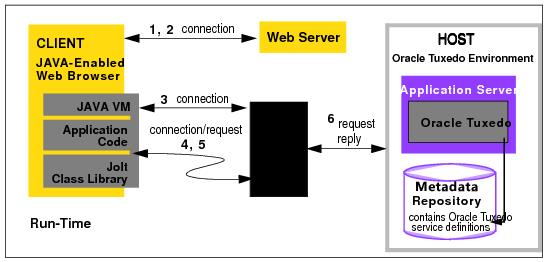Jolt Class Library
The Oracle Jolt Class Library is a set of classes that you can use in your Java application or applet to make service requests to the Oracle Tuxedo system from a Java-enabled client. You access Oracle Tuxedo transaction services by using Jolt class objects.
When developing a Jolt client application, you only need to know about the classes that Jolt provides and the Oracle Tuxedo services that are exported by the Metadata Repository. Jolt hides the underlying application details. To use Jolt and the Jolt Class Library, you do not need to understand: the underlying transactional semantics, the language in which the services were coded, buffer manipulation, the location of services, or the names of databases used.
The Jolt API is a Java class library and has the benefits that Java provides: applets are downloaded dynamically and are only resident during run time. As a result, there is no need for client installation, administration, management, or version control. If services are changed, the client application notes the changes at the next call to the Metadata Repository.
The following figure shows the flow of activity from a Jolt client to and from the Oracle Tuxedo system. The call-out numbers correspond to descriptions of the activity in the following table “Using the Jolt Class Library”.
Figure 1-3 Using the Jolt Class Library to Access Oracle Tuxedo Services

The following table briefly describes the flow of activity involved in using the Jolt Class Library to access Oracle Tuxedo services, as shown in the previous figure “Using the Jolt Class Library to Access Oracle Tuxedo Services.”
Table 1-1 Using the Jolt Class Library
| Process | Step | Action |
|---|---|---|
| Connection | 1 | A Java-enabled Web browser uses HTTP protocol to download an HTML page. |
| ... | 2 | A Jolt applet is downloaded and executed in the Java Virtual Machine on the client. |
| ... | 3 | The first Java applet task is to open a separate connection to the Jolt Server. |
| Request | 4 | The Jolt client now knows the signature of the service (such as name, parameters, types); can build a service request object based on Jolt class definitions, and make a method call. |
| ... | 5 | The request is sent to the Jolt Server, which translates the Java-based request into an Oracle Tuxedo request and forwards the request to the Oracle Tuxedo environment. |
| Reply | 6 | The Oracle Tuxedo system processes the request and returns the information to the Jolt Server, which translates it back to the Java applet. |
Parent topic: How Oracle Jolt Works